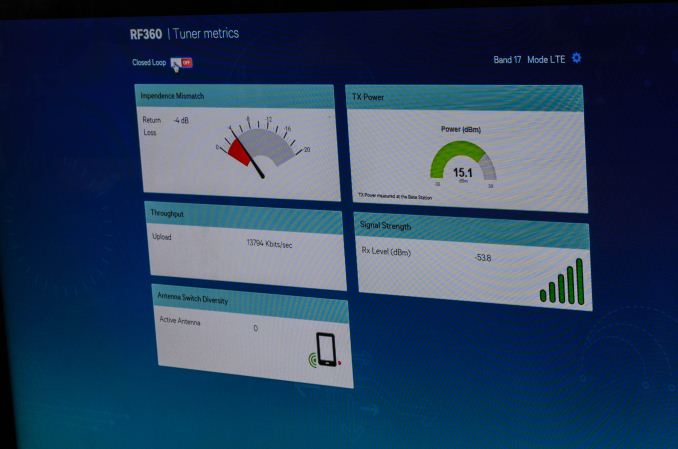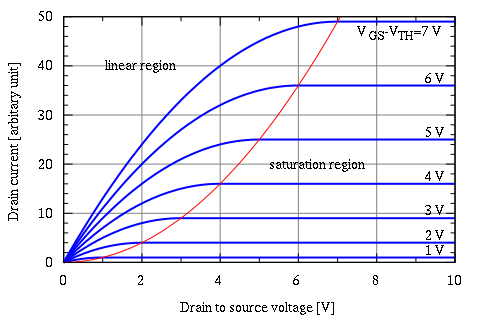Understanding Qualcomm's Snapdragon 810: Performance Preview
by Joshua Ho & Andrei Frumusanu on February 12, 2015 9:00 AM EST- Posted in
- SoCs
- Qualcomm
- Mobile
- Gobi
- Snapdragon 810
QFE2550 Antenna Tuner
One of the first areas to explore would be the RF front end, and before we jump into deep discussions we’ll tackle some of the simpler sections first. The QFE25xx antenna tuner is similar to the envelope tracker in the sense that it’s normally not part of the RF front end. I never actually mentioned an envelope tracker or antenna tuner at any step in the introduction. This is because these parts are not part of the basic superheterodyne radio system. However, like envelope tracking, the need for more battery life, faster data, and superior reception has driven the development of new technologies.
To understand how this antenna tuner works, we must introduce the concept of impedance matching and impedance. Impedance seems difficult at first, but is really just a form of resistance in an AC circuit for the purposes of understanding this article. The three components in a circuit that affect impedance are resistors, capacitors, and inductors. Impedance matching is exactly what it sounds like, which is equalizing the impedance at a junction. In transferring energy from an antenna to the RF front end, we must match the impedance between the antenna and front end. This is because if the impedances are mismatched, signal reflects back to the source. In other words, on the receiving side reception becomes weaker if impedance is mismatched, and on the transmission side energy is wasted. One can liken this to a glossy display, as while the vast majority of the light goes through the glass cover, some light is reflected back.
Of course, in the factory the RF system is carefully tuned to ensure that impedance mismatch is as low as possible. However, the real world makes for a difficult situation. The iPhone 4’s death grip behavior is a classic example of how real-world use can disrupt this impedance matching. By bridging two gaps in the metal ring of the iPhone 4, the antenna was detuned and its impedance was altered. As a result, signal became noticeably worse. Combined with the compressed signal representation, this made it possible for a “decent signal” to be completely lost by touching the right place on the phone.
This is where the QFE2550 antenna tuner and similar systems come in. By acting as a voltage-controlled variable capacitor, the baseband can be loaded with information that allows it to predict how much mismatch correction is needed for each detected scenario, which is accomplished with various sensors that can include capacitive touch sensors. Each situation is compensated for by using pre-loaded corrections that are loaded when a given scenario is detected based on frequency change or body loading scenarios. As a result, the efficiency of the antenna is restored as seen in the photo above, although the presence of body loading will inevitably reduce peak power and sensitivity. Such a system can be combined with more information, such as capacitive touch sensors or reflected power measurements to ensure maximum responsiveness and performance. This has the greatest benefit in enabling phones with all-metal unibodies, although other tools such as antenna switched diversity and MIMO can be used to ensure peak reception.
QFE33xx CMOS PA/Switch
Normally, power amplifiers are not worth talking about. However, with the introduction of RF360 Qualcomm has bandied about the concept of a CMOS PA to cover a wide swath of bands rather than just a few. While this sounds interesting, there’s a great deal more nuance to this issue than simply band coverage. First, semiconductor/solid state physics is required to really understand where the debate lies. Of course, there’s really no time to go over this in major depth, but there are a few basics. The transistor is a switch that controls the flow of current. However, there is a limit to how much current can be carried, and there are a few regions in which the relationship between voltage and current differ. The two that we’ll talk about are the linear region and saturation region. The linear region is exactly what it sounds like. Voltage and current are linearly related, following Ohm’s law. The saturation region is where this falls apart, and more voltage is needed to increase current by the same amount, and we see diminishing returns until maximum current is reached.
"IvsV mosfet" by User:CyrilB. Licensed under CC BY-SA 3.0 via Wikimedia Commons
So this is where we see a fundamental difference in the implementation of a CMOS PA and GaAs PA. Gallium arsenide has higher electron mobility, even in saturation mode. This makes it easier for GaAs circuits to switch at incredibly high frequencies such as 60 GHz for WiGig/802.11ad. In addition, unlike silicon-based transistors, gallium arsenide transistors are generally heat-insensitive, and pure GaAs has high resistance and dielectric constant, which means that it serves as an excellent substrate for various components for the same reasons that silicon-on-insulator (SOI) is a good substrate for CMOS logic. In addition, GaAs-based transistors are highly linear in behavior when compared to CMOS technologies, so a GaAs PA can operate much closer to maximum current without clipping the signal.
However, GaAs is not perfect. For one, CMOS logic is impossible to implement using current technologies. This is because unlike current CMOS technology where there are NMOS and PMOS transistors, GaAs-based transistors do not have a p-channel equivalent. As a result, the controls available over a GaAs PA are significantly cruder than what is possible with a CMOS PA. GaAs PAs are also noticeably less efficient at low power levels, also known as the backoff condition. Therefore, CMOS PAs tend to be more power efficient at lower power states as they can have multiple “maximum power states” to scale the PA as needed. In practice, Qualcomm claims that we’re still looking at around a 5-10% efficiency delta at max power when compared to GaAs PAs, which means that CMOS PAs are close to GaAs PAs in efficiency.
Despite the differences in efficiency, a CMOS PA is still a valid option in smartphones due to the fact that a single PA can cover far more bands than an equivalent GaAs PA, as the PAE curve across a spread of frequencies is relatively flat compared to a GaAs PA which is effectively a single peak. In addition, the fact that the PA is built on CMOS means that there is additional integration capability. In its current incarnation, the QFE33xx already has an integrated antenna switch, and there is potential for greater integration with parts that share a similar process node.
This concludes RF360, which gives a broad survey of what’s on the market today. Combined with our previous piece on MDM9x25, it’s possible to get a good idea of the current state of the market. However, the latest and greatest modems and transceivers mean that it’s time to talk about UE category 6, 9, and 10 LTE and the various challenges that come with new capabilities.














119 Comments
View All Comments
twizzlebizzle22 - Thursday, February 12, 2015 - link
The speed on modern/flagship SoCs are phenomenal. The right implementation and power savings are what I'm focussed on this year.ddriver - Thursday, February 12, 2015 - link
Either there is a typo in the "PNG Comp ST" test, or Exynos 5433 is ~1000 times faster than the competition...MrCommunistGen - Thursday, February 12, 2015 - link
Probably a comma instead of a decimal point. You'll see that the Multithreaded PNG score for the Exynos 5433 is roughly in line with the other SoCs and much "lower" than the Single Threaded score.Mondozai - Thursday, February 12, 2015 - link
"The speed on modern/flagship SoCs are phenomenal."Yes, but not this chip. It's going to be Qualcomm's main chip in 2015, it's still getting beaten by year old tech. Then again, the OEMs want a "total solution" and while Nvidia is crushing them in the GPU benchmarks, Nvidia still doesn't have a good integrated LTE solution, for example.
Nevertheless, GPU power matters. This SoC will struggle with 4K and its supposed to be the high-end. Disappointing.
Makaveli - Thursday, February 12, 2015 - link
Does 4k really matter that much on a 5' display?fokka - Thursday, February 12, 2015 - link
i say no, but sadly that is where the market will go, especially onphablets and tablets. there already are rumours about an lg g4 with a 1800p screen and as we see on qualcomm's reference platform, i'm pretty sure we'll see some 4k tablets enter the market pretty soon.Frenetic Pony - Friday, February 13, 2015 - link
Then don't buy their bullshit, that's easy enough. Anything beyond 1080 for subs 6" is ridiculous and wasteful.Uplink10 - Friday, February 13, 2015 - link
I think anything beyond HD for a smartphone is worthless, difference is not worth the price and energy. Do people need 4K, FullHD, QHD screens because they edit photos and videos on their smartphone which we then see in the cinemas?xnay - Saturday, February 14, 2015 - link
I totally agree with you. And I'm waiting impatiently for the new HTC M9 because it's said to be using 1080p display.Laststop311 - Friday, February 20, 2015 - link
Im with you. I wish they woul stick to standard full HD and focus on improving reflectance of outside light to a lower percentage (better performance in this area is critical it allows easier viewing in sunlight without having to crank the brightness up and use more power), Luminance per watt for either brighter screen or same brightness but less power (which is easily possible if they quit using smaller pixels that block more of the backlight), better color accuracy and gamma with even a higher bit screen to display more color while keeping accuracy high. Pre calibrated with professional tools at the factory the way dell does with their high end u3014.Almost 100% of people I know would trade a couple extra hours of battery life to have less pixels. Less pixels = less power used by gpu, lower power backlight needed, less heat from backlight generated, smaller backlight needed (can make phone a bit thinner), more responsive phone when scrolling less pixels have to be renedered for the scroll animation so it's smoother and faster and uses less energy. And there isn't really a downside. You would have to have super human eagle eyes to see this difference between 1080 RGB strip and 1440 RGB stripe. Many more benefits sticking with 1080. Anything higher is utterly ridiculous for a 5-6 inch phone.
I could honestly get by with 1280 x 720 or 1366 x x756 or whatever it is. I loved the screen on my 5.5" galaxy note 2 with RGB stripe 1280x720 AMOLED. Everything looked plenty crisp and switching to the note 4 sure things do look a bit more crisp but just imagine the battery life saved if it was 1280x720. Bet hours would be added to it.